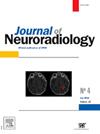The apparent diffusion coefficient color Map for evaluating a large ischemic core
IF 3
3区 医学
Q2 CLINICAL NEUROLOGY
引用次数: 0
Abstract
Introduction
Our previous work demonstrated that evaluating large ischemic cores using the apparent diffusion coefficient (ADC) could predict EVT outcomes, with the most frequent ADC (peak ADC) ≥520×10–6 mm2/s associated with better clinical results. Since the degree of ADC reduction reflects the severity of ischemic stress, this study aimed to assess the utility of an ADC color map in visualizing this stress.
Patients and methods
This retrospective cohort study included consecutive patients with a low Alberta Stroke Program Early Computed Tomography Score (ASPECTS) using diffusion-weighted imaging (DWI) who underwent successful EVT recanalization between April 2014 and March 2023. To create a visual representation of ischemic stress, we assigned different colors to diffusion-weighted image (DWI) lesions based on their ADC values: ≥520×10–6 mm2/s, 520–440×10–6 mm2/s, and <440×10–6 mm2/s. We compared patients with peak ADC ≥520×10–6 mm2/s to those with lower peak ADC to identify factors associated with the higher value.
Results
A total of 78 patients were enrolled, with 34 having a peak ADC ≥520×10–6 mm2/s. The optimal ratio for discriminating peak ADC ≥520×10–6 mm2/s was found to be 60 % for the volume of the lesion with ADC ≥520×10–6 mm2/s (ADC520) relative to the total DWI lesion volume. This ratio demonstrated a sensitivity of 86 % and a specificity of 82 %.
Discussion and conclusion
The ADC color map effectively portrays the depth of ischemic stress. A large ischemic core with an ADC520/DWI ratio >60 % may be salvageable with EVT. This approach offers a visual means for assessing EVT suitability in acute large ischemic stroke.
视扩散系数彩色图评价大面积缺血核。
我们之前的研究表明,使用表观扩散系数(ADC)评估大缺血核心可以预测EVT结果,最常见的ADC(峰值ADC)≥520×10-6 mm2/s与更好的临床结果相关。由于ADC减少的程度反映了缺血应激的严重程度,本研究旨在评估ADC颜色图在可视化这种应激中的效用。患者和方法:这项回顾性队列研究纳入了2014年4月至2023年3月期间使用弥散加权成像(DWI)进行EVT再通成功的低阿尔伯塔卒中项目早期计算机断层扫描评分(ASPECTS)的连续患者。为了创建缺血应激的视觉表示,我们根据弥散加权图像(DWI)病变的ADC值为其分配不同的颜色:≥520×10-6 mm2/s, 520-440×10-6 mm2/s和-6 mm2/s。我们将ADC峰值≥520×10-6 mm2/s的患者与ADC峰值较低的患者进行比较,以确定与较高值相关的因素。结果:共入组78例患者,其中34例ADC峰值≥520×10-6 mm2/s。对于ADC≥520×10-6 mm2/s的病变体积(ADC520)相对于DWI病变总体积而言,鉴别峰值ADC≥520×10-6 mm2/s的最佳比例为60%。该比率的敏感性为86%,特异性为82%。讨论与结论:ADC颜色图有效地描绘了缺血应激的深度。ADC520/DWI比值约为60%的大缺血核可通过EVT修复。这种方法为评估急性大面积缺血性卒中EVT的适宜性提供了一种直观的方法。
本文章由计算机程序翻译,如有差异,请以英文原文为准。
求助全文
约1分钟内获得全文
求助全文
来源期刊

Journal of Neuroradiology
医学-核医学
CiteScore
6.10
自引率
5.70%
发文量
142
审稿时长
6-12 weeks
期刊介绍:
The Journal of Neuroradiology is a peer-reviewed journal, publishing worldwide clinical and basic research in the field of diagnostic and Interventional neuroradiology, translational and molecular neuroimaging, and artificial intelligence in neuroradiology.
The Journal of Neuroradiology considers for publication articles, reviews, technical notes and letters to the editors (correspondence section), provided that the methodology and scientific content are of high quality, and that the results will have substantial clinical impact and/or physiological importance.
 求助内容:
求助内容: 应助结果提醒方式:
应助结果提醒方式:


